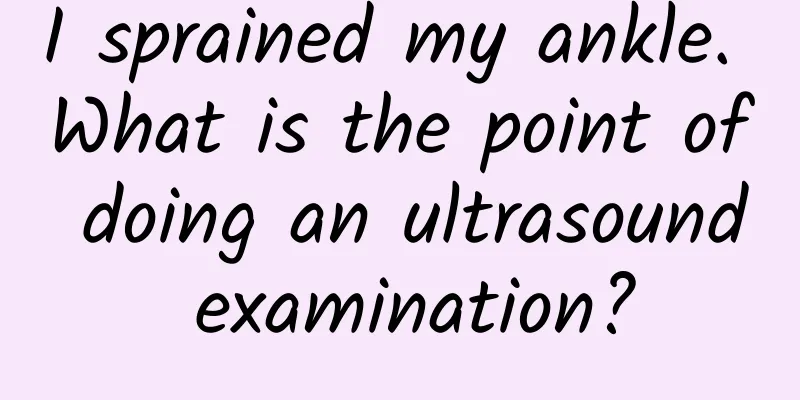I sprained my ankle. What is the point of doing an ultrasound examination?

|
Author: Guo Ruijun, Chief Physician, Beijing Chaoyang Hospital, Capital Medical University Reviewer: Li Jun, Chief Physician, Peking University First Hospital Currently, ultrasound is the preferred method for examining muscle and tendon injuries. Figure 1 Original copyright image, no permission to reprint Compared with CT and MRI, ultrasound has the following advantages: First, it is economical. Ultrasound is more economical than MRI and CT. An ultrasound examination costs about 120 yuan, but an MRI examination costs about 500 yuan. For ordinary people, if they can clearly judge the condition by ultrasound, there is naturally no need for MRI examination. Second, it is fast and convenient. In sports venues, the Olympic Games, and the World Cup, you can take a portable ultrasound to check injured athletes at any time, but CT and MRI cannot do that because CT and MRI are very large examination equipment and are not convenient to carry. Therefore, the speed and practicality of ultrasound are reflected. Third, during the examination, the doctor and the patient are face to face. When the doctor and the patient are face to face, it is convenient to ask about the medical history and injury history, including the posture at the time of injury, and the treatment situation, etc. This is crucial for ultrasound diagnosis, and this is precisely what CT and MRI cannot do. Because CT and MRI are performed by technicians or technicians, and the examination results are also completed by the radiologist reading the film. Fourth, it is called Compare Examination. Generally speaking, most people have one side that is diseased and the other side is normal. For example, if one side has tennis elbow (lateral epicondylitis of the humerus) and the other side is normal, ultrasound can easily check the normal side first, and then compare to see the difference on the injured side. This is the fourth advantage of ultrasound. Fifth, less damage. We know that ultrasound examinations can be done during prenatal checkups, and at least there is no evidence that it causes significant damage to the human body. Of course, we do not recommend that pregnant women do too many ultrasound examinations, but X-rays, whether CT or plain films, have a fatal flaw, which is the so-called radiation damage. For example, in life, many people are prone to spraining their ankles, that is, ankle injuries. Most patients have lateral ankle ligament injuries, and some other ligaments are completely torn or partially torn, and joint cavity bleeding may also occur. Tearing and bleeding will definitely cause swelling. Many people do not go to the hospital or undergo musculoskeletal ultrasound examinations after ankle injuries or sprains, and do not know which ligament is problematic, whether the ligament is completely torn or partially torn. Although the patient's symptoms can gradually improve, after three months or a period of time, the sprain reappears. This is called habitual sprains. In fact, the ligament is damaged and the balance is disrupted. For example, if a telephone pole is perpendicular to the ground, the traction ropes on both sides must be balanced. If there is a problem with the traction rope on one side, the telephone pole will definitely tilt. The same is true for the ankle joint. Whether it is the ligaments on both sides or other soft tissues, once there is damage, the stability of the ankle joint will be a problem, so it is easy to sprain the ankle again. We call this habitual sprain. Figure 2 Original copyright image, no permission to reprint Therefore, if you are prone to spraining your ankle, you must have an ultrasound examination to see which ligament is damaged or torn and how severe the condition is. At the same time, you should also have an X-ray examination to see if there are any problems with the bones, such as the tibia and fibula, calcaneus, metatarsal bones, etc., to see if there are any fractures. Through these examinations, after a clear diagnosis is made, targeted treatment can be given to avoid recurring ankle sprains in the future. |
<<: Musculoskeletal ultrasound—correct interpretation of common terms!
>>: Why does femoral head necrosis occur? Is conservative treatment effective?
Recommend
The benefits of eating sweets for women
Many people can not resist the temptation of dess...
How high is the altitude of Ali in Tibet? How is the sweet tea drunk by Tibetans in Tibet made?
The Tibet Autonomous Region, abbreviated as Tibet...
Will it be painful to remove the IUD after menopause?
In order to achieve the purpose of effective cont...
Normal values of inhibin b in women
Female inhibin b is closely related to female rep...
Women will feel comfortable if they persist for 3 minutes every night
Nowadays, most women sit in the office all day an...
What is the average age of menopause?
I believe that menstruation is a topic that every...
What is the effect of eating longan during menstruation?
Longan contains a variety of nutrients and has a ...
Why does pregnant women's urine smell bad?
Women's bodies will experience various change...
What should I do if I have a cold and cough during my fifth month of pregnancy?
Some pregnant women have encountered dangerous si...
Why does the vaginal discharge have blood streaks after abortion?
Many people have undergone abortions due to unexp...
Fruit beauty skin care tips
Fruit is a kind of food that we all like very muc...
In vitro fertilization egg and sperm retrieval: Parents’ cleanliness obsession can save the baby’s life!
Author: Chen Weiwei, Chief Technician, Sichuan Ji...
How to use the contraceptive patch
There are many contraceptive devices and tools cu...
What is the embryo implantation process?
Every normal woman needs to go through the proces...
What causes itching around the female urethra?
Symptoms of itching around the urethral opening a...









